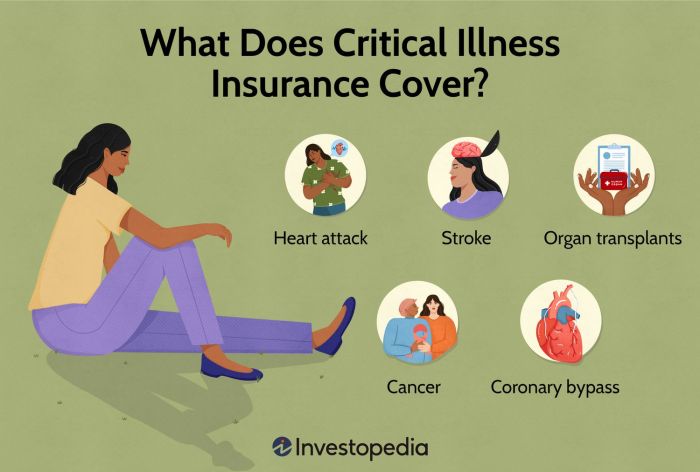
In delving into the realm of Critical Illness Cover Explained: Who Needs It Most?, readers are invited into a well-informed space designed to offer an absorbing and original reading experience.
The following paragraphs will provide detailed insights and information on the topic at hand.
Overview of Critical Illness Cover

Critical Illness Cover is a type of insurance policy that provides a lump sum payment if the policyholder is diagnosed with a critical illness that is listed in the policy. This lump sum payment can help cover medical expenses, loss of income, or any other financial burdens that may arise due to the illness.
What Does Critical Illness Cover Include?
Critical Illness Cover typically includes coverage for serious medical conditions such as cancer, heart attack, stroke, organ transplant, and major organ failure. These are illnesses that can have a significant impact on a person’s life and finances, making the lump sum payment crucial in such situations.
- Cancer: Critical Illness Cover often includes coverage for various types of cancer, providing financial support for treatments and care.
- Heart Attack: This coverage can offer assistance with medical bills, rehabilitation, and lifestyle adjustments after a heart attack.
- Stroke: Critical Illness Cover can help cover the costs associated with recovery and ongoing care following a stroke.
- Organ Transplant: In the event of an organ transplant, the lump sum payment can help with expenses related to the procedure and post-transplant care.
- Major Organ Failure: Coverage for major organ failure can provide financial support for treatments or procedures like dialysis or organ replacement.
Who Needs Critical Illness Cover
When it comes to Critical Illness Cover, certain individuals can benefit greatly from having this type of insurance in place. Let’s explore who needs Critical Illness Cover the most and why.
Identifying High-Benefit Individuals
People who have dependents, such as children or elderly parents, are highly recommended to consider Critical Illness Cover. This insurance provides financial protection in case of a serious illness, ensuring that your loved ones are taken care of even if you are unable to work.
Scenarios Where Critical Illness Cover is Vital
In situations where the primary breadwinner of the family falls critically ill, having Critical Illness Cover can be a lifesaver. It can help cover medical expenses, mortgage payments, or other financial obligations during a difficult time.
Statistics on Critical Illness Occurrences
According to recent data, critical illnesses such as cancer, heart attacks, and strokes are becoming increasingly common. In fact, studies show that 1 in 3 people are likely to develop cancer in their lifetime. These statistics highlight the importance of being prepared with Critical Illness Cover to avoid financial hardship in case of a medical emergency.
Coverage Details and Limitations
When it comes to Critical Illness Cover, the coverage typically includes a range of serious illnesses such as cancer, heart attack, stroke, organ transplant, and others. In the event that the policyholder is diagnosed with one of the covered conditions, a lump sum payment is made to help cover medical expenses, loss of income, or any other financial burdens that may arise.
Common Inclusions in Critical Illness Cover
- Cancer
- Heart Attack
- Stroke
- Organ Transplant
- Multiple Sclerosis
Limitations and Exclusions
It is important to note that Critical Illness Cover may have limitations and exclusions. For example, pre-existing conditions may not be covered, and certain illnesses such as self-inflicted injuries or drug-related illnesses may be excluded from the policy.
Comparison of Insurance Providers
- Provider A offers coverage for a wider range of critical illnesses compared to Provider B.
- Provider B has a higher maximum payout limit for critical illness claims than Provider A.
- Provider C includes additional benefits such as coverage for alternative treatments or rehabilitation services.
Cost and Affordability
When it comes to Critical Illness Cover, the cost can vary depending on several factors. Understanding these factors can help you find an affordable policy that meets your needs.
Factors Influencing Cost
- The age and health of the individual: Younger and healthier individuals typically pay lower premiums.
- The coverage amount: Higher coverage amounts usually result in higher premiums.
- Medical history: Pre-existing conditions may lead to higher costs or exclusions.
- Smoking status: Smokers are often charged higher premiums due to increased health risks.
- Occupation: Riskier occupations may lead to higher premiums.
Tips for Finding Affordable Cover
- Compare quotes from multiple insurers to find the best rate.
- Consider term life policies with critical illness riders for cost-effective coverage.
- Maintain a healthy lifestyle to potentially lower your premiums.
- Review your coverage needs regularly to ensure you’re not over-insured.
Justification of Cost
While the cost of Critical Illness Cover may seem high, it is justified by the financial protection and peace of mind it offers. In the event of a serious illness, the lump sum payment can help cover medical expenses, ongoing care, and other financial obligations.
This can prevent a significant financial burden on you and your loved ones during a challenging time.
Additional Benefits and Options
When it comes to Critical Illness Cover, policyholders can often enjoy additional benefits and options that enhance their coverage and provide extra financial protection in times of need. These extra features can be crucial in ensuring comprehensive support during challenging times.
Optional Riders for Enhanced Coverage
- Waiver of Premium: This rider allows policyholders to waive their premium payments if they are diagnosed with a critical illness, ensuring that the policy remains in force without any financial burden.
- Income Protection Benefit: With this rider, policyholders receive a steady income stream if they are unable to work due to a critical illness, helping them cover their daily expenses and maintain financial stability.
- Children’s Critical Illness Cover: This optional add-on provides coverage for children against specified critical illnesses, offering peace of mind to parents and ensuring the well-being of their little ones.
Customization Options for Policyholders
- Sum Assured Flexibility: Policyholders can choose the sum assured amount based on their individual needs and financial obligations, ensuring that they have adequate coverage in place.
- Term Extension: Some insurers offer the option to extend the policy term beyond the standard duration, providing continued coverage for a longer period and enhancing the overall protection offered by the policy.
- Additional Illness Coverage: Policyholders may have the option to add coverage for more critical illnesses beyond the standard list, ensuring a wider safety net against various health conditions.
Closure
Concluding our discussion, this summary encapsulates the key points discussed, leaving readers with a memorable takeaway on the importance of Critical Illness Cover.
Top FAQs
Who is eligible for Critical Illness Cover?
Individuals between certain age limits without pre-existing critical illnesses are usually eligible. It’s best to check with insurance providers for specific details.
Can Critical Illness Cover be purchased for family members?
Yes, it is possible to buy Critical Illness Cover for family members, providing them with financial protection in case of a critical illness.
Is Critical Illness Cover a substitute for health insurance?
No, Critical Illness Cover is designed to provide a lump sum payment upon diagnosis of a critical illness, while health insurance covers medical expenses.
Are all critical illnesses covered under Critical Illness Cover?
Coverage varies among insurance providers, but most policies include common critical illnesses such as cancer, heart attack, and stroke.













